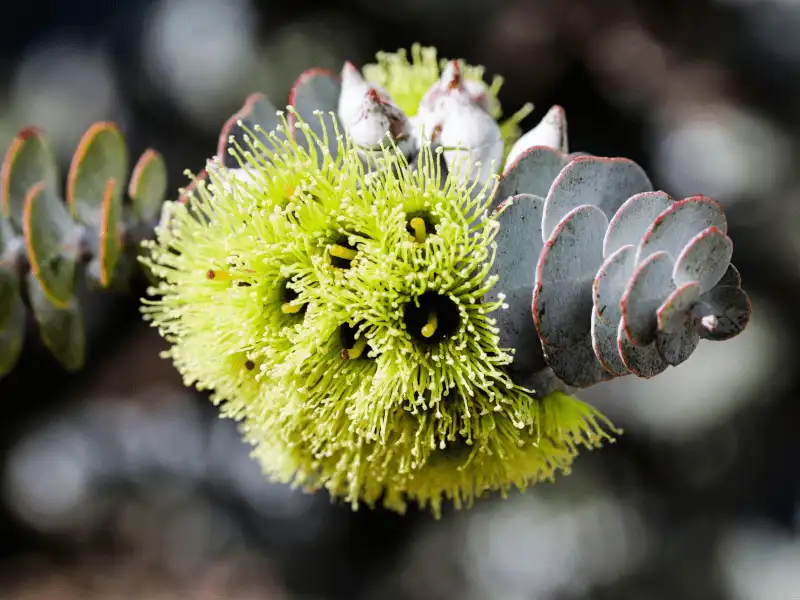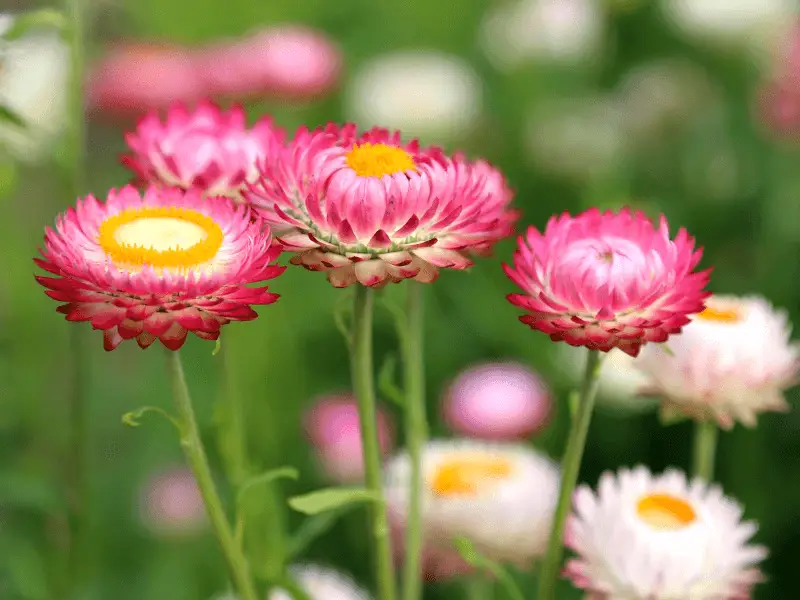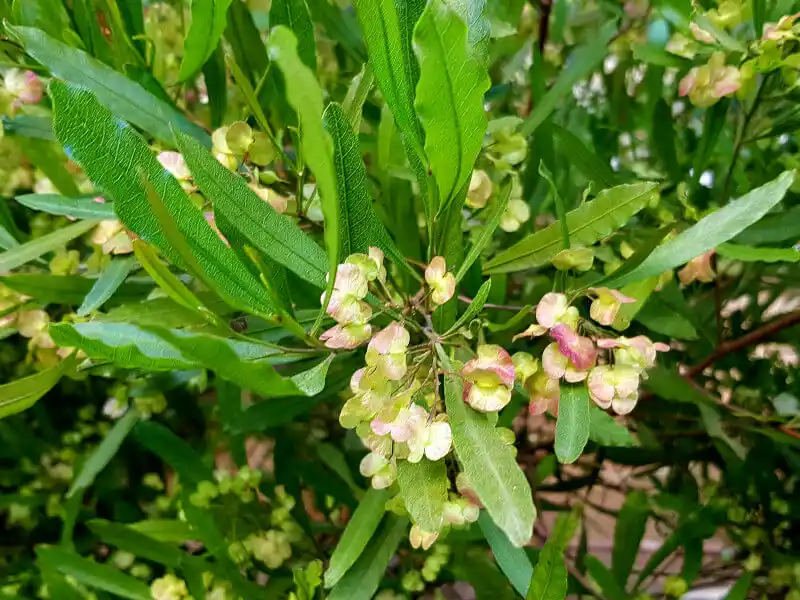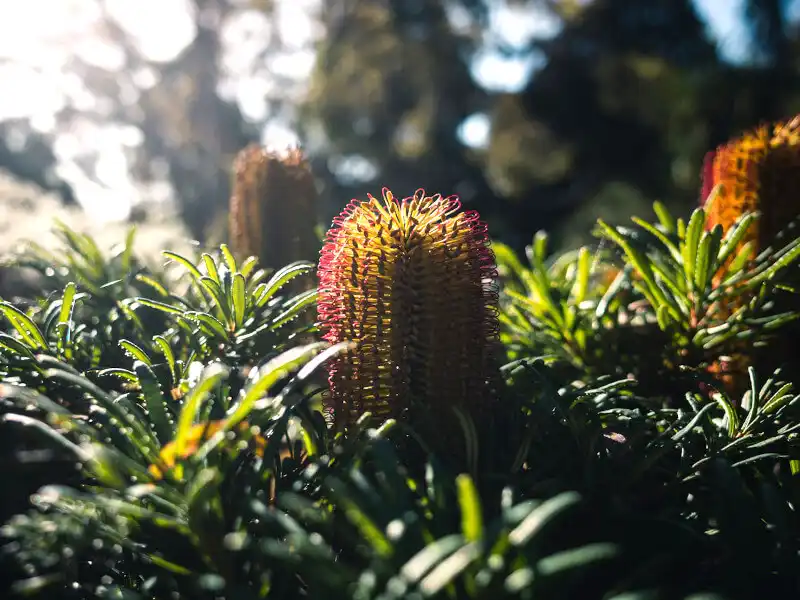
| Botanic name | Banksia spinulosa |
| Other names | Hairpin banksia |
| Main Origin | East Coast of Australia |
| Mature size | 1 – 3 m x 1 – 3 m (w x h) |
| Mature form | Shrub or small tree with a rounded canopy |
| Foliage | Narrow, linear or oblong, leathery, dark green |
| Growth rate | Slow to moderate |
| Position | Full sun, light shade |
| Soil | Adapts to most soils |
| Water | Regular deep watering during prolonged dry periods |
| Climate | Mediterranean, temperate, subtropical |
| Flower | Cylindrical, orange-yellow spikes from autumn to spring |
| Use | Feature specimen, border planting, informal hedge, screening |
| Notes | Suitable for coastal gardens |
IN THIS ARTICLE
Overview
Loved for its eye-catching flower spikes, fine-textured foliage, and versatility in the landscape, Banksia spinulosa, or Hairpin Banksia, has quietly earned a devoted following among native plant enthusiasts.
Beyond its visual appeal, this plant is highly valued for its ecological role. It supports pollinators and attracts local wildlife, contributing to the broader biodiversity.
Banksia spinulosa is easy to grow and adaptable to various conditions. It is a favourite among novice gardeners for its resilience, and among landscape designers for its versatility in informal, naturalistic, and habitat-focused plantings.
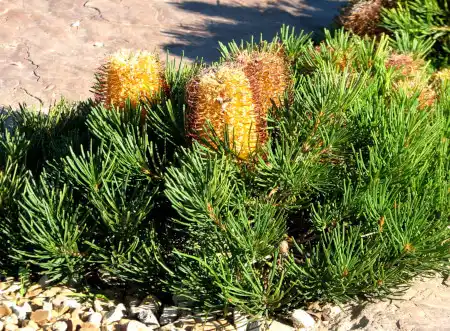
Origin and distribution
Banksia spinulosa is native to eastern Australia, with a natural distribution from coastal to subcoastal regions, where it occurs in coastal heaths, open forests, shrublands, woodlands and swamp margins. In exposed sites, plants often appear shorter than those growing in more sheltered conditions.
Banksia spinulosa is divided into several subspecies, each reflecting slight variations in form, foliage, and flower characteristics across its broad eastern Australian range. These subspecies are typically associated with specific regions and habitats, from coastal heathlands to inland woodlands.
While they all share the species’ signature flower spikes and adaptability, their diversity has contributed to the emergence of numerous garden cultivars. In cultivation, the subspecies are often blended through hybridisation, making Banksia spinulosa one of the most horticulturally versatile and widely grown banksias.
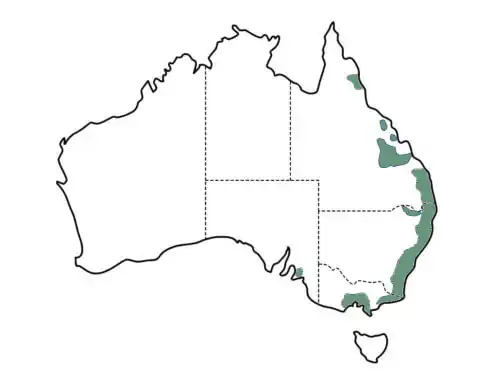
Growth and care
Hairpin Banksia thrives in various climates, including subtropical, warm temperate, cool temperate, and Mediterranean zones. It thrives in both full sun and light shade.
The plant is frost-tolerant and can withstand temperatures as low as -8°C. It can also tolerate prolonged heat up to 40°C. While the species adapts to a range of temperatures, it thrives best in warmer conditions.
Banksia spinulosa is mostly found on sandy soils, but can also establish in moderately heavy clay soils or clay loams. The plant prefers slightly acidic to neutral soils and can struggle in alkaline or lime-rich soils, which can cause leaf yellowing.
Often associated with coastal heaths along the coastline, the species demonstrates good tolerance to salinity, making it highly suitable for seaside gardens. However, it is not a dedicated frontline plant and will not sustain full-on coastal exposure.
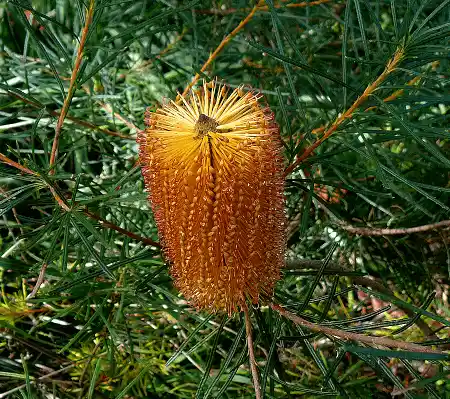
Banksia species have evolved to thrive in poor soils. Their specialised proteoid roots are highly effective in absorbing minimal water and nutrients. High levels of nutrients, particularly phosphorus, in the soil can harm many Banksia plants, including Banksia spinulosa and its varieties.
As such, they do not often require additional feeding. However, if the plant shows signs of slow growth or pale leaves, minimal applications of the low-phosphorus fertiliser can be beneficial.
Banksia spinulosa is responsive to pruning. It can be trimmed to maintain shape and encourage denser growth. Start by removing dead or unsightly branches. Regularly tip-prune when young to achieve an attractive, compact form.
Remove spent flower heads, dead or dying wood, and any undesirable leggy growth to achieve a tidy form. You can even hard prune to the base if it forms a lignotuber (a storage organ commonly seen in Mallee eucalypts) to rejuvenate the plant.
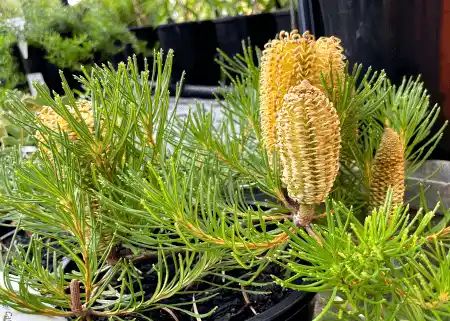
Features
Banksia spinulosa is often a multi-stemmed shrub that grows to 1 – 3 metres tall with a similar spread, with smooth or slightly tessellated grey-brown bark. It naturally adopts a tidy, rounded, and compact habit, but can become irregular, spindly or leggy in dense shade.
Depending on the subspecies and cultivars, the plant can appear low-spreading or upright and bushy. Its leaves are leathery, stiff, narrow-linear, narrow-elliptical, or oblong, with finely toothed margins. They are mostly dark green on the surface, with a paler underside.
The key feature is its spectacular, intriguing flower spikes, which are cylindrical in shades of orange-yellow, often with dark maroon hooked styles that give the ‘hairpin’ impression. The sizable blooms can reach 10 – 20 cm long and 6 cm wide.
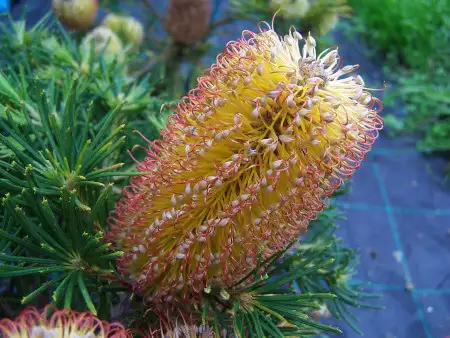
Banksia spinulosa blooms from autumn to spring. Their unique, bold form and vibrant, rich colours create a sensational drama in colder months, while few species flower. The long-lasting flowers are rich in nectar, drawing a flurry of birds, bees, and other pollinators to the garden.
After the flower spikes fade, they dry out and gradually turn woody, developing into distinctive seed cones that remain on the plant for months or even years. In its habitat, fire and extreme heat prompt seed release, a trait common to many banksias.
In the garden, they serve as a subtle reminder of the plant’s resilience and ecological origins. Many gardeners leave them in place for texture and form, while others prune them to encourage a tidier look and stimulate fresh growth and flowering.
Banksia spinulosa has long held strong appeal in the floral industry for its bold, long-lasting flower spikes and architectural form. Its flowers maintain their structure well after cutting, and even the woody, dried cones are prized for adding rustic, sculptural elements to dried floral designs.
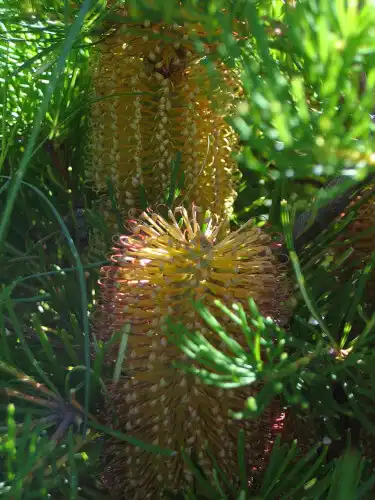
Varieties
- Banksia spinulosa var. spinulosa: A low-growing, compact shrub with a mounded or spreading habit, ideal for groundcovers or borders, reaching 1 – 2 metres tall and wide, lignotuber present.
- Banksia spinulosa var. collina: A slightly larger variety with broader leaves and a dense habit, ideal for hedging and screening, reaching 2 – 3 metres tall and wide, lignotuber present.
- Banksia spinulosa var. cunninghamii: A larger, fast-growing, feature shrub or small tree with a more open habit, reaching 3 – 5 metres tall and wide, less tolerant of hard pruning due to the absence of lignotuber.
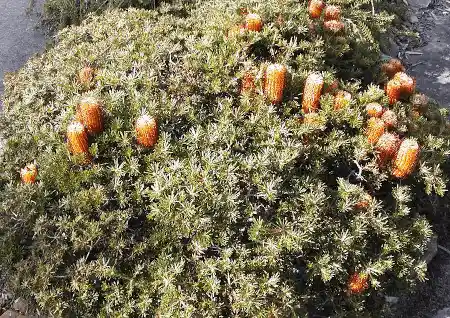
Dwarf cultivars
- Banksia ‘Birthday Candles’: The most well-known and widely grown dwarf cultivar, with a compact and mounded habit to 60 cm tall and 1 metre wide.
- Banksia ‘Cherry Candles’: A close relative to ‘Birthday Candles’, highly compact with deep cherry red styles on its golden flower spikes, growing to 50 cm tall and wide.
- Banksia ‘Dwarf Red’: Another close relative of ‘Birthday Candles’, featuring large golden flowers covered with deep red styles, reaching 60 cm tall and wide.
- Banksia ‘Coastal Cushion’: A low-growing, spreading variety with a dense habit, often used as a border and groundcover plant, reaching 60 cm tall and 1 – 1.5 metres wide.
- Banksia ‘Stumpy Gold’: A compact, spreading cultivar of Banksia spinulosa var. collina, with a semi-prostrate profile to 50 cm tall and 1.2 metres wide.
- Banksia ‘Golden Cascade’: A prostrate variety with a delightful cascading habit, perfect as a groundcover or border plant with a height of 30 cm and a 1.5 – 2 metre spread.
- Banksia ‘Honey Pots’: A dwarf shrub with a dense, mounding habit, growing to about 1 metre high and 1.2 metres wide, with large golden flower spikes.
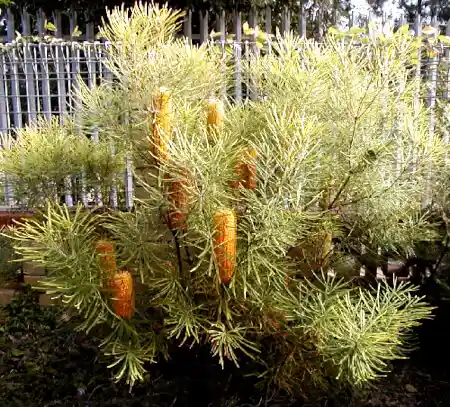
Shrubby cultivars
- Banksia ‘Bird Song’: A hybrid with Banksia ericifolia, featuring dense branches, smaller, bright green foliage, and bird-attracting nectar-rich flowers, reaching 1.5 metres tall and wide.
- Banksia ‘Yellow Wing’: A cross between Banksia ‘Giant Candles’ and Banksia spinulosa var. collina, with a rounded, compact form to 1.8 metres tall and wide, featuring large orange flower spikes.
- Banksia ‘Lemon Glow’: A Banksia spinulosa var. cunninghamii cultivar, featuring long lemon-yellow flower spikes contrasting with dark green foliage, growing to about 2 – 3 metres tall and wide.
- Banksia ‘Giant Candles’: Another hybrid with Banksia ericifolia, featuring impressive, large flower spikes up to 40 cm long, growing to about 4 metres tall.
- Banksia ‘Carnarvon Gold’: A cultivar derived from Banksia spinulosa var. Collina, featuring golden yellow flower spikes, growing 2 – 5 metres tall and 2 – 4 metres wide.
